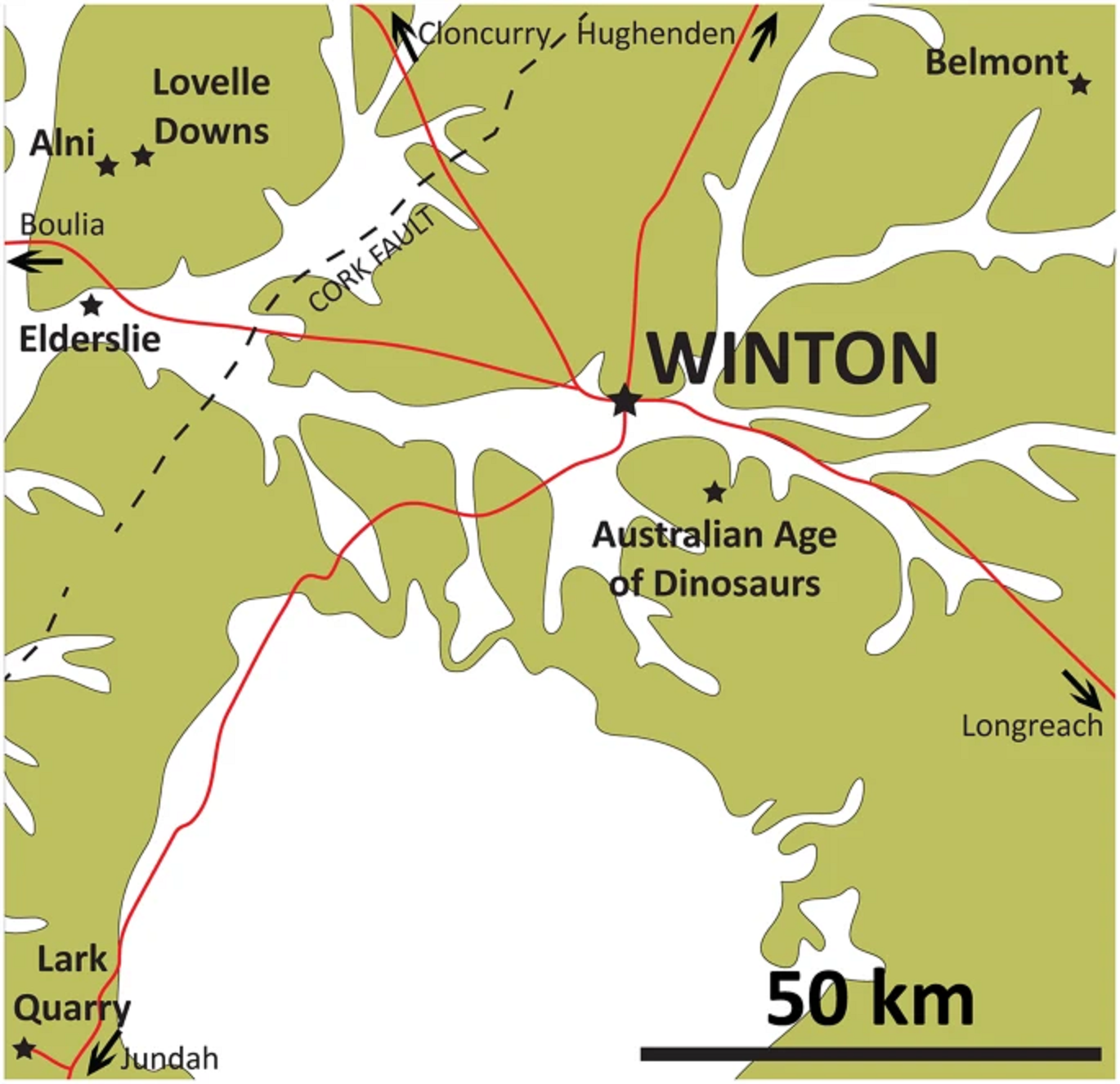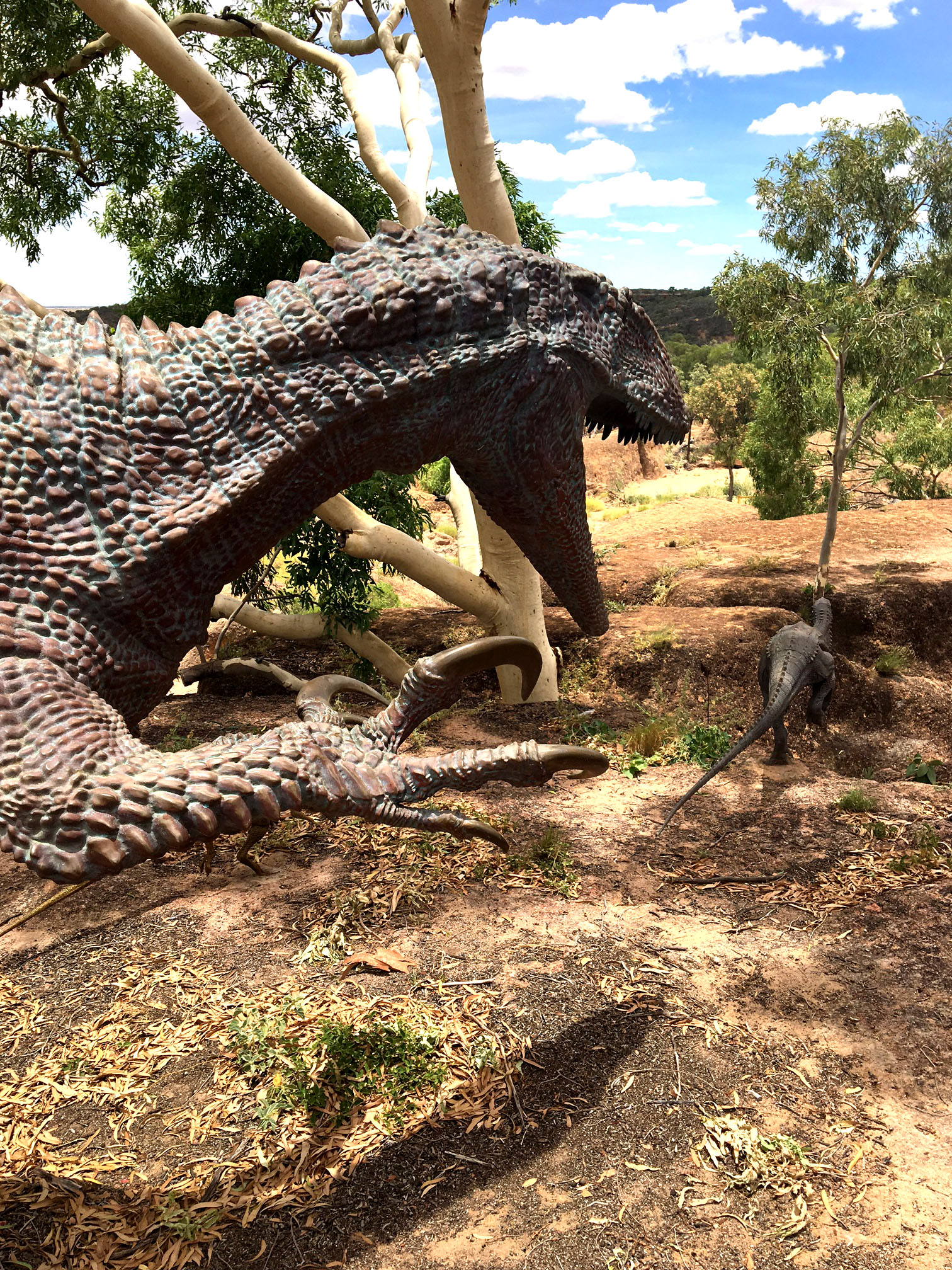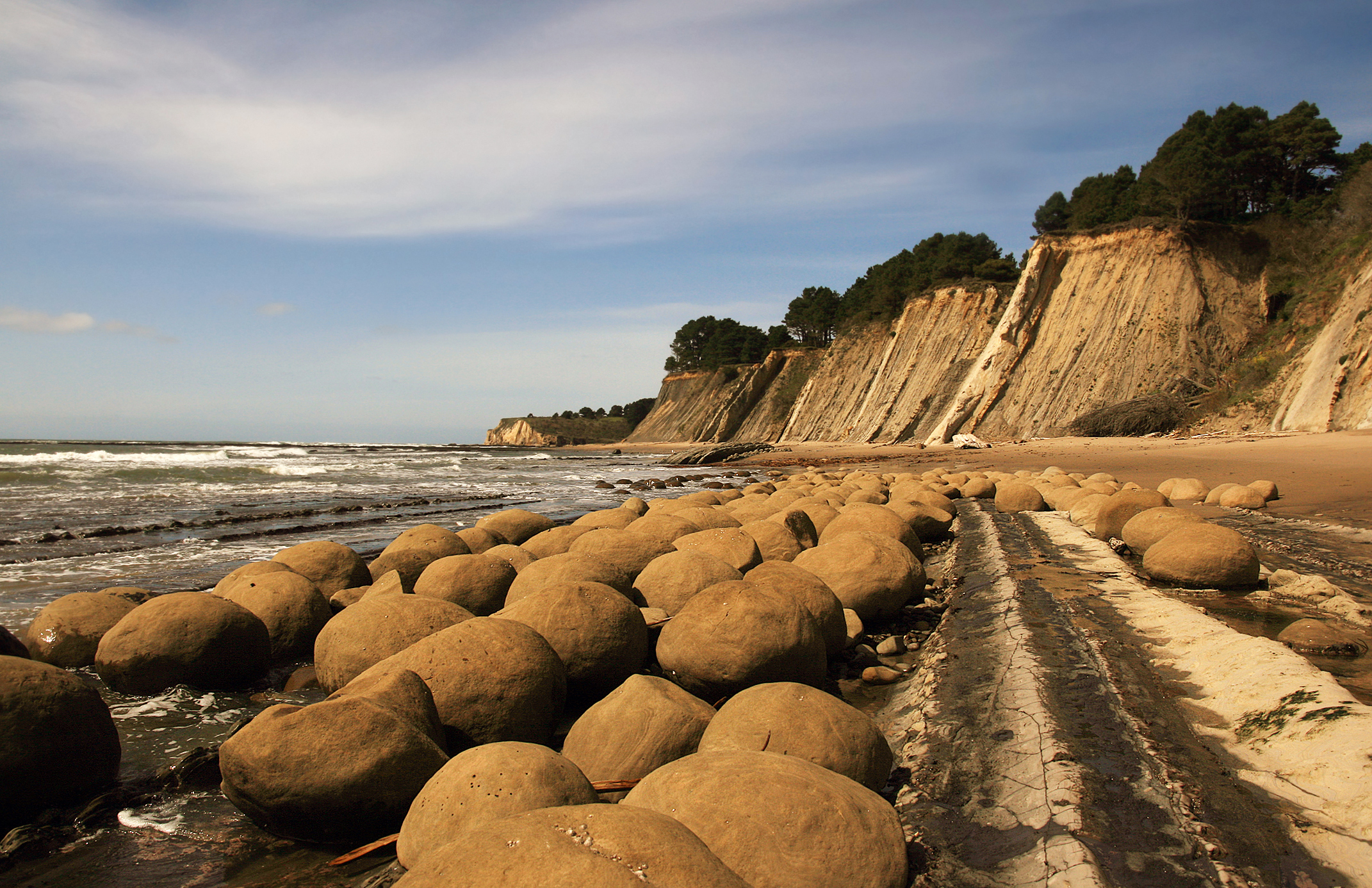|
Savannasaurus
''Savannasaurus'' is a genus of titanosaurian sauropod dinosaur from the Late Cretaceous Winton Formation of Queensland, Australia. It contains one species, ''Savannasaurus elliottorum'', named in 2016 by Stephen Poropat and colleagues. The holotype and only known specimen, originally nicknamed "Wade", is the most complete specimen of an Australian sauropod, and is held at the Australian Age of Dinosaurs museum. Dinosaurs known from contemporary rocks include its close relative ''Diamantinasaurus'' and the theropod ''Australovenator''; associated teeth suggest that ''Australovenator'' may have fed on the holotype specimen. At long, ''Savannasaurus'' was a medium-sized titanosaur. It is notable for its wide hips, which would have been over wide at their widest points. This would have distributed its body weight more evenly, along with a robust (upper arm bones) and possibly also the tall (ankle bone). Combined with a flexible vertebral column, these traits would have made ''Sav ... [...More Info...] [...Related Items...] OR: [Wikipedia] [Google] [Baidu] |
Australian Age Of Dinosaurs
Australian Age of Dinosaurs Ltd (AAOD) is a not for profit organisation located in Winton, Queensland and founded by David Elliott and Judy Elliott in 2002. The organisation's activities include operation of the Australian Age of Dinosaurs Museum of Natural History (the Museum) which holds annual dinosaur digs in the Winton FormationCook, A.G., Bryan, S.E. & Draper, J.J. (2012).Post-orogenic Mesozoic basins and magmatism. Pp 515-575. In Jell, P.A. (ed.). Geology of Queensland. (Geological Survey of Queensland, Brisbane) of western Queensland and oversees the year-round operation of Australia's most productive dinosaur fossil preparation laboratory. Since 2005, the AAOD Museum has accumulated the largest collection of Australian dinosaur fossils in the world and holds the holotype specimens of ''Diamantinasaurus matildae''Hocknull, S.A., White, M.A., Tischler, T.R., Cook, A.G., Calleja, N.D., Sloan, T., Elliott, D.A., (2009) New mid-Cretaceous (latest Albian) dinosaurs from Winton ... [...More Info...] [...Related Items...] OR: [Wikipedia] [Google] [Baidu] |
Diamantinasaurus
''Diamantinasaurus'' is a genus of titanosaurian sauropod from Australia that lived during the early Late Cretaceous, about 94 million years ago. The type species of the genus is ''D. matildae'', first described and named in 2009 by Scott Hocknull and colleagues based on fossil finds in the Winton Formation. Meaning "Diamantina lizard", the name is derived from the location of the nearby Diamantina River and the Greek word ''sauros'', "lizard". The specific epithet is from the Australian song Waltzing Matilda, also the locality of the holotype and paratype. The known skeleton includes most of the forelimb, shoulder girdle, pelvis, hindlimb and ribs of the holotype, and one shoulder bone, a radius and some vertebrae of the paratype. History of discovery The holotype of ''Diamantinasaurus'' was first uncovered over four seasons of excavations near Winton, Queensland, Australia. The bones were found alongside the holotype of ''Australovenator'' and crocodylomorphs and molluscs. Th ... [...More Info...] [...Related Items...] OR: [Wikipedia] [Google] [Baidu] |
Winton Formation
The Winton Formation is a Cretaceous geological formation in central-western Queensland, Australia. It is late Albian to early Turonian in age. The formation blankets large areas of central-western Queensland. It consists of sedimentary rocks such as sandstone, siltstone and claystone. The sediments that make up these rocks represent the remnants of the river plains that filled the basin left by the Eromanga Sea - an inland sea that covered large parts of Queensland and central Australia at least four times during the Early Cretaceous. Great meandering rivers, forest pools and swamps, creeks, lakes and coastal estuaries all left behind different types of sediment. In some areas, the Winton Formation is over 400 metres thick. To bring with them such a huge amount of sediment, the rivers that flowed across these plains must have been comparable in size to the present-day Amazon or Mississippi rivers. As more and more sediment was brought in, the margins of the inland sea slowly ... [...More Info...] [...Related Items...] OR: [Wikipedia] [Google] [Baidu] |
Titanosaur
Titanosaurs (or titanosaurians; members of the group Titanosauria) were a diverse group of sauropod dinosaurs, including genera from all seven continents. The titanosaurs were the last surviving group of long-necked sauropods, with taxa still thriving at the time of the extinction event at the end of the Cretaceous. This group includes some of the largest land animals known to have ever existed, such as '' Patagotitan''—estimated at long with a weight of —and the comparably-sized '' Argentinosaurus'' and ''Puertasaurus'' from the same region. The group's name alludes to the mythological Titans of ancient Greek mythology, via the type genus (now considered a '' nomen dubium)'' '' Titanosaurus''. Together with the brachiosaurids and relatives, titanosaurs make up the larger sauropod clade Titanosauriformes. Titanosaurs have long been a poorly-known group, and the relationships between titanosaur species are still not well-understood. Description Titanosauria have the lar ... [...More Info...] [...Related Items...] OR: [Wikipedia] [Google] [Baidu] |
Lithostrotia
Lithostrotia is a clade of derived titanosaur sauropods that lived during the Early Cretaceous and Late Cretaceous. The group was defined by Upchurch ''et al.'' in 2004 as the most recent common ancestor of '' Malawisaurus'' and '' Saltasaurus'' and all the descendants of that ancestor. Lithostrotia is derived from the Ancient Greek , meaning "inlaid with stones", referring to the fact that many known lithostrotians are preserved with osteoderms. However, osteoderms are not a distinguishing feature of the group, as the two noted by Unchurch ''et al.'' include caudal vertebrae with strongly concave front faces (procoely), although the farthest vertebrae are not procoelous. History of research In 1895, Richard Lydekker named the family Titanosauridae to summarize sauropods with procoelous (concave on the front) caudal vertebrae. The name Titanosauridae has since been widely used, and was defined by Salgado and colleagues (1997), Gonzalaz-Riga (2003), and Salgado (2003) as a node- ... [...More Info...] [...Related Items...] OR: [Wikipedia] [Google] [Baidu] |
Winton, Queensland
Winton is a town and locality in the Shire of Winton in Central West Queensland, Australia. It is northwest of Longreach. The main industries of the area are sheep and cattle raising. The town was named in 1876 by postmaster Robert Allen, after his place of birth, Winton, Dorset. Winton was the first home of the airline Qantas. History Dispossession of Aboriginal land owners The traditional owners of the Winton area, the Koa people, consider Bladensburg National Park area (near Winton) to be a special part of their traditional country, and the park is also important to the Maiawali and Karuwali people. Jirandali (also known as Yirandali, Warungu, Yirandhali) is an Australian Aboriginal language of North-West Queensland, particularly the Hughenden area. The language region includes the local government area of the Shire of Flinders, including Dutton River, Flinders River, Mount Sturgeon, Caledonia, Richmond, Corfield, Winton, Torrens, Tower Hill, Landsborough Cre ... [...More Info...] [...Related Items...] OR: [Wikipedia] [Google] [Baidu] |
Fossil Preparation
Fossil preparation is the act of preparing fossil specimens for use in paleontological research or for exhibition, and involves removing the surrounding rocky matrix and cleaning the fossil. Techniques Acid maceration Acid maceration is a technique to extract organic microfossils from a surrounding rock matrix using acid. Hydrochloric acid or acetic acid may be used to extract phosphatic fossils, such as the small shelly fossils, from a carbonate matrix. Hydrofluoric acid is also used in acid macerations to extract organic fossils from silicate rocks. Fossiliferous rock may be immersed directly into the acid, or a cellulose nitrate film may be applied ( dissolved in amyl acetate), which adheres to the organic component and allows the rock to be dissolved around it. Film pull The film pull technique is a means of recovering carbonaceous compression fossils for study under transmitted light microscopy. An acid is applied to the surface of the rock to etch away the matrix fro ... [...More Info...] [...Related Items...] OR: [Wikipedia] [Google] [Baidu] |
Siltstone
Siltstone, also known as aleurolite, is a clastic sedimentary rock that is composed mostly of silt. It is a form of mudrock with a low clay mineral content, which can be distinguished from shale by its lack of fissility.Blatt ''et al.'' 1980, pp.381-382 Although its permeability and porosity is relatively low, siltstone is sometimes a tight gas reservoir rock, an unconventional reservoir for natural gas that requires hydraulic fracturing for economic gas production. Siltstone was prized in ancient Egypt for manufacturing statuary and cosmetic palettes. The siltstone quarried at Wadi Hammamat was a hard, fine-grained siltstone that resisted flaking and was almost ideal for such uses. Description There is not complete agreement on the definition of siltstone. One definition is that siltstone is mudrock ( clastic sedimentary rock containing at least 50% clay and silt) in which at least 2/3 of the clay and silt fraction is composed of silt-sized particles. Silt is defi ... [...More Info...] [...Related Items...] OR: [Wikipedia] [Google] [Baidu] |
Concretion
A concretion is a hard, compact mass of matter formed by the precipitation of mineral cement within the spaces between particles, and is found in sedimentary rock or soil. Concretions are often ovoid or spherical in shape, although irregular shapes also occur. The word 'concretion' is derived from the Latin "(act of) compacting, condensing, congealing, uniting", itself from ''con'' meaning 'together' and ''crescere'' meaning "to grow". Concretions form within layers of sedimentary strata that have already been deposited. They usually form early in the burial history of the sediment, before the rest of the sediment is hardened into rock. This concretionary cement often makes the concretion harder and more resistant to weathering than the host stratum. There is an important distinction to draw between concretions and nodules. Concretions are formed from mineral precipitation around some kind of nucleus while a nodule is a replacement body. Descriptions dating from the 18th ... [...More Info...] [...Related Items...] OR: [Wikipedia] [Google] [Baidu] |
Gypsum
Gypsum is a soft sulfate mineral composed of calcium sulfate dihydrate, with the chemical formula . It is widely mined and is used as a fertilizer and as the main constituent in many forms of plaster, blackboard or sidewalk chalk, and drywall. Alabaster, a fine-grained white or lightly tinted variety of gypsum, has been used for sculpture by many cultures including Ancient Egypt, Mesopotamia, Ancient Rome, the Byzantine Empire, and the Nottingham alabasters of Medieval England. Gypsum also crystallizes as translucent crystals of selenite. It forms as an evaporite mineral and as a hydration product of anhydrite. The Mohs scale of mineral hardness defines gypsum as hardness value 2 based on scratch hardness comparison. Etymology and history The word '' gypsum'' is derived from the Greek word (), "plaster". Because the quarries of the Montmartre district of Paris have long furnished burnt gypsum ( calcined gypsum) used for various purposes, this dehydrated gyp ... [...More Info...] [...Related Items...] OR: [Wikipedia] [Google] [Baidu] |
Cenomanian
The Cenomanian is, in the ICS' geological timescale, the oldest or earliest age of the Late Cretaceous Epoch or the lowest stage of the Upper Cretaceous Series. An age is a unit of geochronology; it is a unit of time; the stage is a unit in the stratigraphic column deposited during the corresponding age. Both age and stage bear the same name. As a unit of geologic time measure, the Cenomanian Age spans the time between 100.5 and 93.9 million years ago (Mya). In the geologic timescale, it is preceded by the Albian and is followed by the Turonian. The Upper Cenomanian starts around at 95 Mya. The Cenomanian is coeval with the Woodbinian of the regional timescale of the Gulf of Mexico and the early part of the Eaglefordian of the regional timescale of the East Coast of the United States. At the end of the Cenomanian, an anoxic event took place, called the Cenomanian-Turonian boundary event or the "Bonarelli event", that is associated with a minor extinction event for ... [...More Info...] [...Related Items...] OR: [Wikipedia] [Google] [Baidu] |








